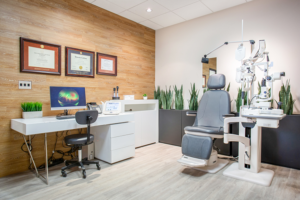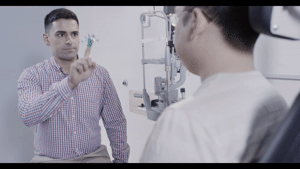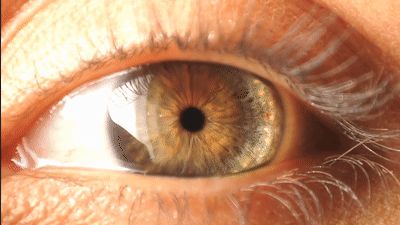
Most people don’t have their first eye exam until they’re 40 years old! It’s very common to not know what to expect when coming in to get your eyes checked. In this article, we’ll run through a typical eye exam. You’ll learn about some of the tools and equipment we use and why we check all those things. Every eye exam at Anderson & Shapiro is tailored to your needs, so your testing may be a little different.

Check In
When you first arrive, you’ll see our reception staff to check in. After welcoming you, we’ll make sure we have your correct address, contact information, ID, and insurance information. Next, we check to see if your insurance requires a co-payment for your visit with us and collect it. We’ll review your Patient Financial Responsibility and you’ll have a chance to review our Privacy Practices. Finally, we’ll get a photo of you for your chart. You’ll have a seat in our waiting room.
Your Technician
As close to your appointment time as possible, one of our technicians will call you from the waiting room. The technician’s job is to perform many tests the doctor requires to ensure your eye health.

First, we’ll take you to a machine called an Auto-Refractor. It projects light rays into your eye and measures how they bounce back out. It estimates what your glasses prescription should be. They’re good for a “ball-park” idea of your glasses prescription, but are not accurate enough to give you a prescription from alone.
“What Brings You In?”

Next, you’re off to an exam room. You get the big chair, while the doctor and technicians sit on the stools in the room. Each of our rooms does have room for one guest with you.
Every exam is different and we need to find some details on why you made your appointment. Maybe you just have never had an exam and want to make sure your eyes are OK. Maybe you’ve started to have more trouble seeing street signs or fine print. Maybe your eyes are itchy, scratchy, or they burn. Whatever the reason, let your technician know. They’re highly trained and will have some specific follow-up questions for you. Common questions include how long it’s been a problem, whether it’s one or both of your eyes, if you’ve tried any treatments or noticed any patterns to when you have these problems.
Health History

Sometimes, different health conditions like high blood pressure, diabetes, or arthritis can affect your eyes. Some medications also have side-effects specific to your eyes, so your technician will get a detailed medical history. Because our office is independent of any other health system, we do not have access to your full medical record.
Eye Testing

Next, we’ll check your Visual Acuity, or how sharply you can see. We check how well you see far away as well as up close. We check one eye at a time and will sometimes check them both together. We’ll also check how your eyes focus and will get some numbers to help generate a glasses prescription.
On top of checking how you see centrally, we’ll make sure you don’t have any blind spots out to the sides.

We check your eyes movements to make sure they can move freely and completely in the sockets. We want to and that they move together in a coordinated manner.
Your pupils can be a window to your brain, or at least some parts of it. Your technician will look to ensure they are reacting properly.
Eye pressure is one of the vital signs of the eyes and just like you’d get your blood pressure checked at a routine health checkup, we check your eye pressure at every visit. You can think of it as a “glaucoma check”, but we don’t puff any air into your eyes.

In order for the doctor to see every part of your eye, we use “dilation” eye drops to make your pupil very large. It usually takes 15-20 minutes for the eye drops to take effect.
Your Doctor
By now you may be thinking, “what is left for the doctor to do?” Our technicians’ job is to gather information – to put the puzzle pieces on the table… it’s up to the doctor to put the puzzle together.


Your doctor will review your chart and problems that you told your technician about. Then, they’ll use a special microscope to take a look at your eyes. The microscopes we use offer 6x to 40x magnification and different colored lights to better see different parts of your eyes. Even though it has that magnification, the microscope can’t see very far inside your eyes without an extra lens to focus the light. That extra lens will feel very bright and you might notice you can see lines in your vision. You’re seeing your own blood vessels!
Your doctor will often be accompanied by another technician, called a scribe. Their job is to make notes in your chart. For example, they’ll record the conversation and recommendations your doctor makes, send medication prescriptions, and answer any final questions you might have.
During an examination, your doctor is looking at many different structures to make sure there is no disease. You may hear your doctor speak another language to their scribe to describe the anatomy they’re seeing – these medical terms have Latin and Greek roots. Don’t worry, we’ll translate to English for you at the end.
Check Out
All that’s left is to head back to the reception desk. Here, we’ll help you set up your next appointment and get a copy of your glasses prescription, if you need it.

Optical
Our Optician, Lee Ann, is an expert at helping choose appropriate frames, lens materials, and get measurements to fit them to your face exactly. She is available by appointment, so check with our receptionists if you need help with glasses!